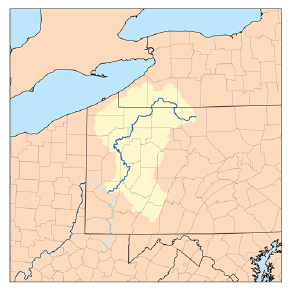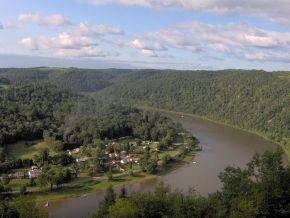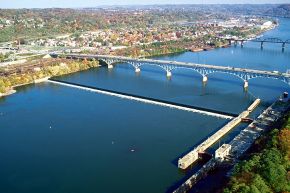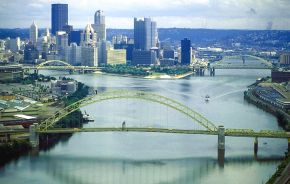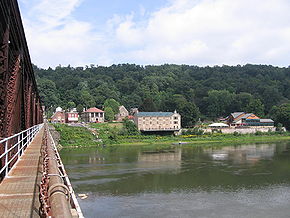Difference between revisions of "Allegheny River" - New World Encyclopedia
Mary Anglin (talk | contribs) m |
Mary Anglin (talk | contribs) |
||
| Line 6: | Line 6: | ||
| mouth = [[Ohio River]] | | mouth = [[Ohio River]] | ||
| basin_countries = [[USA]] | | basin_countries = [[USA]] | ||
| − | | length = 325 miles (523 km) | + | | length = 325 miles (523 km) |
| − | | elevation = ~2,490 feet (759 m) | + | | elevation = ~2,490 feet (759 m) |
| − | | discharge = | + | | discharge = {{convert|16700|cuft/s|m3/s|abbr=on}} at the town of [[Natrona, Pennsylvania|Natrona]] in [[Harrison Township, Allegheny County, Pennsylvania]] |
| − | | watershed = | + | | watershed = {{convert|11580|sqmi|km2|abbr=on}} |
}} | }} | ||
{{ImageStackRight|310| | {{ImageStackRight|310| | ||
| + | |||
[[Image:Alleghenyrivermap.png|thumb|right|290px|Allegheny River watershed]] | [[Image:Alleghenyrivermap.png|thumb|right|290px|Allegheny River watershed]] | ||
| + | |||
[[Image:Allegheny River Bend.jpg|thumb|right|290px|Much of the area through which the Allegheny River flows consists of hilly woodlands.]] | [[Image:Allegheny River Bend.jpg|thumb|right|290px|Much of the area through which the Allegheny River flows consists of hilly woodlands.]] | ||
| + | |||
[[Image:USACE Lock and Dam 2 Allegheny.jpg|thumb|290px|Lock and Dam No. 2 on the Allegheny River in [[Aspinwall, Pennsylvania]]. The Highland Park Bridge crosses the river just above the dam.]] | [[Image:USACE Lock and Dam 2 Allegheny.jpg|thumb|290px|Lock and Dam No. 2 on the Allegheny River in [[Aspinwall, Pennsylvania]]. The Highland Park Bridge crosses the river just above the dam.]] | ||
| + | |||
[[Image:Allegheny Monongahela Ohio.jpg|thumb|290px|The Allegheny (left) and Monongahela (right) join to form the Ohio River at Pittsburgh, Pennsylvania.]]}} | [[Image:Allegheny Monongahela Ohio.jpg|thumb|290px|The Allegheny (left) and Monongahela (right) join to form the Ohio River at Pittsburgh, Pennsylvania.]]}} | ||
| − | |||
| − | The | + | The '''Allegheny River''' is a principal [[tributary]] of the [[Ohio River]] and is located in the [[Eastern United States]]. It joins with the [[Monongahela River]] to form the [[Ohio River]] at "[[Point State Park#History|The Point]]" of [[Point State Park]] in [[Downtown Pittsburgh]], [[Pennsylvania]]. |
| − | + | The river is approximately {{convert|325|mi}} long, running through the [[U.S. state]]s of [[New York]] and [[Pennsylvania]]. It drains a rural [[dissected plateau]] of {{convert|11580|sqmi|km2}} in the northern [[Allegheny Plateau]], providing the northeastern most drainage in the watershed of the [[Mississippi River]]. Its tributaries reach to within {{convert|8|mi}} of [[Lake Erie]] in southwestern New York. The valley of the river has been one of the most productive areas of energy extraction in U.S. history, with extensive deposits of [[coal]], [[petroleum]], and [[natural gas]]. | |
| − | The | ||
| − | + | The word ''Allegheny'' comes from the [[Lenape]] (Delaware) Indians. Although it is usually translated as "fine river", the meaning is not definitively known. There is a Lenape legend of a tribe called "Allegewi" who used to live along the river. Other Indians, such as the [[Iroquois]], considered the Allegheny and Ohio rivers as the same, as is suggested by a New York State road sign on [[Interstate 86 (east)|Interstate 86]] that refers to the Allegheny river secondarily as ''O Hi Yo''.<ref>[[George R. Stewart|Stewart, George R.]] (1967, pg. 8) Names on the Land. Boston: Houghton Mifflin Company.</ref> Areas around the river, in the [[U.S. state|State]] of [[New York]], are often named with an alternate spelling ''Allegany'' in reference to the river, such as the Village of [[Allegany (village), New York|Allegany, New York]]. | |
| − | == | + | == Course == |
| − | |||
| − | |||
| − | ==History== | + | The Allegheny rises in north central Pennsylvania, in central [[Potter County, Pennsylvania|Potter County]], approximately 10 miles (16 km) south of the New York border. It flows west past [[Coudersport, Pennsylvania|Coudersport]] then turns north into western New York State, looping westward across southern [[Cattaraugus County, New York|Cattaraugus County]] for approximately 30 miles (48 km), past Portville, [[Olean, New York|Olean]], [[St. Bonaventure University]] and [[Salamanca, New York|Salamanca]] and forming the northern boundary of [[Allegany State Park]] before re-entering northwestern Pennsylvania approximately 20 miles (32 km) southeast of [[Jamestown, New York]]. |
| − | In the 16th century, control of the river valley passed back-and-forth between [[Algonquian language|Algonquian]]-speaking [[Shawnee]] and the [[Iroquois]]. By the time of the arrival of the [[France|French]] in the early 18th century, the Shawnee were once again in control and formed an alliance with the French against the incursion of [[Kingdom of Great Britain|British]] settlement across the [[Allegheny Mountains]]. The conflict over the expansion of British settlement into the Allegheny Valley and the surrounding [[Ohio Country]] was a primary cause of the [[French and Indian War]] in the 1750s. During the war, [[Kittanning (village)|the village of Kittaning]], the principal Shawnee settlement on the river, was [[Kittanning Expedition|completely destroyed]] by British reprisal raids from | + | |
| + | It flows in a broad zigzag course generally southward across western Pennsylvania, first flowing southwest past [[Warren, Pennsylvania|Warren]], [[Tidioute]], [[Tionesta]], [[Oil City, Pennsylvania|Oil City]], and [[Franklin, Pennsylvania|Franklin]], forming much of the northwestern boundary of [[Allegheny National Forest]]. South of Franklin it turns southeast across [[Clarion County, Pennsylvania|Clarion County]] in a [[meander]]ing course, then turns again southwest across [[Armstrong County, Pennsylvania|Armstrong County]], flowing past [[Kittanning, Pennsylvania|Kittanning]], [[Ford City, Pennsylvania|Ford City]], Clinton and [[Freeport, Pennsylvania|Freeport]]. It enters [[Allegheny County, Pennsylvania|Allegheny County]], the [[Pittsburgh, Pennsylvania|Pittsburgh]] suburbs, and the City of Pittsburgh from the northeast passing Sligo, Karns, and [[Natrona, Pennsylvania|Natrona]] in [[Harrison Township, Allegheny County, Pennsylvania|Harrison Township]], then Braeburn, Lower Burrell, Brackenridge, Tarentum, Creighton, Clyde, New Kensington, Springdale, Harmarville, Blawnox, Fox Chapel, Sharpsburg, Etna, Millvale, Lawrenceville, Highland Park, The North Side, Downtown Pittsburgh, Point State Park and joins with the [[Monongahela River]] at "The Point" in Downtown Pittsburgh, Pennsylvania to form the [[Ohio River]]. Water from the Allegheny River eventually flows into the [[Gulf of Mexico]] via the Ohio River and the [[Mississippi River]]. | ||
| + | |||
| + | == Tributaries == | ||
| + | |||
| + | In its upper reaches the Allegheny is joined from the south by [[Potato Creek]] in [[McKean County, Pennsylvania]] and from the north by [[Olean Creek]] at [[Olean, New York]]. The [[Great Valley, New York|Great Valley Creek]] and [[Little Valley, New York|Little Valley Creek]] join the river from the north in [[Salamanca, New York]] before becoming the [[Allegheny Reservoir]]. After re-entering Pennsylvania, it is joined from the east by [[Kinzua Creek]] 10 miles (16 km) upstream of Warren; from the north by [[Conewango Creek]] at Warren; from the west by [[Brokenstraw Creek (Allegheny River)|Brokenstraw Creek]]; from the north by [[Oil Creek (Allegheny River)|Oil Creek]] at Oil City; from the west by [[French Creek (Allegheny River)|French Creek]] at Franklin; from the east by the [[Clarion River]] in [[Parker, Pennsylvania]], one of its principal tributaries, in eastern Clarion County; from the east by [[Crooked Creek (Pennsylvania)|Crooked Creek]] southeast of Kittanning; and from the east by the [[Kiskiminetas River]], another principal tributary, at [[Freeport, Pennsylvania|Freeport]]. Buffalo Creek enters at Freeport, Bull Creek enters at Tarentum. There are many other creeks, runs and streams that enter or join with the Allegheny River. | ||
| + | |||
| + | == History == | ||
| + | |||
| + | In the 16th century, control of the river valley passed back-and-forth between [[Algonquian language|Algonquian]]-speaking [[Shawnee]] and the [[Iroquois]]. By the time of the arrival of the [[France|French]] in the early 18th century, the Shawnee were once again in control and formed an alliance with the French against the incursion of [[Kingdom of Great Britain|British]] settlement across the [[Allegheny Mountains]]. The conflict over the expansion of British settlement into the Allegheny Valley and the surrounding [[Ohio Country]] was a primary cause of the [[French and Indian War]] in the 1750s. During the war, [[Kittanning (village)|the village of Kittaning]], the principal Shawnee settlement on the river, was [[Kittanning Expedition|completely destroyed]] by British reprisal raids from Central Pennsylvania. | ||
Nevertheless, the British, after gaining control of the area in the 1763 [[Treaty of Paris (1763)|Treaty of Paris]], kept the area closed to white settlement, in part to repair and maintain relations with the Native Americans. The pressure to open the river valley and the surrounding area to settlement is considered by historians to be one of the root causes of the [[American Revolutionary War]] in the following decade. | Nevertheless, the British, after gaining control of the area in the 1763 [[Treaty of Paris (1763)|Treaty of Paris]], kept the area closed to white settlement, in part to repair and maintain relations with the Native Americans. The pressure to open the river valley and the surrounding area to settlement is considered by historians to be one of the root causes of the [[American Revolutionary War]] in the following decade. | ||
| Line 36: | Line 45: | ||
During the 19th century, the river became a principal means of navigation in the upper Ohio valley, especially for the transport of [[coal]]. Although the building of the railroads lessened the importance of the river somewhat, the lower river (navigable as far as [[East Brady, Pennsylvania]] through locks) has continued to serve as route of commercial transportation until the present day. In 1859, the first U.S. petroleum was drilled north of the river at [[Titusville, Pennsylvania|Titusville]]. | During the 19th century, the river became a principal means of navigation in the upper Ohio valley, especially for the transport of [[coal]]. Although the building of the railroads lessened the importance of the river somewhat, the lower river (navigable as far as [[East Brady, Pennsylvania]] through locks) has continued to serve as route of commercial transportation until the present day. In 1859, the first U.S. petroleum was drilled north of the river at [[Titusville, Pennsylvania|Titusville]]. | ||
| − | In 1965, the completion of the federally-sponsored [[Kinzua Dam]] for [[flood]]-control in northwestern Pennsylvania east of Warren created the long [[Allegheny Reservoir]], part of which is included in the [[Allegheny National Recreation Area]]. The dam flooded parts of lands deeded "forever" to the [[Seneca | + | In 1965, the completion of the federally-sponsored [[Kinzua Dam]] for [[flood]]-control in northwestern Pennsylvania east of Warren created the long [[Allegheny Reservoir]], part of which is included in the [[Allegheny National Recreation Area]]. The dam flooded parts of lands deeded "forever" to the [[Seneca Nation of Indians]] by the 1794 [[Treaty of Canandaigua]], and to lands given to [[Cornplanter]] and his descendants. (The event is described in the [[Johnny Cash]] tune "As Long as the Grass Shall Grow.") |
| − | + | Many prominent individuals opposed the construction of the dam at that time because of the damage it would do to Seneca lands, including Pennsylvania Congressman [[John P. Saylor]] of [[Johnstown, Pennsylvania|Johnstown]], and [[Howard Zahniser]], executive director of [[The Wilderness Society]] and native of [[Tionesta, Pennsylvania]] — a small town located on the Allegheny River several miles downstream of Warren. During the campaign for the [[1960 United States presidential election]], [[John F. Kennedy]] assured the Seneca Nation that he would oppose the dam if elected. However, he failed to follow through on his pledge upon becoming president. | |
| − | + | The construction of the dam and the filling of the Allegheny Reservoir also necessitated the elimination of the small town of Corydon, which was located at the confluence of Willow Creek with the Allegheny River, and the small town of Kinzua, which was located at the confluence of Kinzua Creek with the Allegheny River. All residents of both towns were forced to move. | |
| − | |||
| − | |||
| − | |||
| − | |||
| − | |||
| − | |||
| − | |||
| − | |||
| − | |||
| − | |||
| − | |||
| − | |||
| − | |||
| − | |||
| − | |||
| − | |||
| − | |||
| − | |||
| − | |||
| − | |||
| − | |||
| − | |||
| − | |||
| − | |||
| − | |||
| − | |||
| − | |||
| − | |||
| − | |||
| − | |||
| − | |||
| − | |||
| − | |||
| − | |||
| − | |||
| − | |||
| − | |||
| − | |||
| − | |||
| − | |||
| − | |||
| − | |||
| − | |||
| − | |||
| − | |||
| − | |||
| − | |||
| − | |||
| − | |||
| − | == | + | In 1992, {{convert|86.6|mi}} of the Allegheny was designated [[National Wild and Scenic River|Wild and Scenic]]. This designation comprises three segments of the river located in [[Warren County, Pennsylvania|Warren]], [[Forest County, Pennsylvania|Forest]] and [[Venango County, Pennsylvania|Venango]] Counties.<ref>[http://www.fs.fed.us/r9/forests/allegheny/recreation/wild_and_scenic_rivers/allegheny/ Allegheny Wild and Scenic River] - Allegheny National Forest</ref> |
| − | *[[ | + | |
| − | *[[ | + | == Cities and towns along the Allegheny River == |
| − | *[[ | + | |
| − | *[[ | + | === New York === |
| − | *[[ | + | |
| + | * [[Allegany (village), New York|Allegany]] | ||
| + | * [[Carrollton, New York|Carrollton]] | ||
| + | * [[Olean (city), New York|Olean]] | ||
| + | * [[Portville (village), New York|Portville]] | ||
| + | * [[St. Bonaventure, New York|St. Bonaventure]] | ||
| + | * [[Salamanca (city), New York|Salamanca]] | ||
| + | * [[Weston Mills, New York|Weston Mills]] | ||
| + | |||
| + | === Pennsylvania === | ||
| + | |||
| + | * [[Applewold, Pennsylvania|Applewold]] | ||
| + | * [[Arnold, Pennsylvania|Arnold]] | ||
| + | * [[Aspinwall, Pennsylvania|Aspinwall]] | ||
| + | * [[Blawnox, Pennsylvania|Blawnox]] | ||
| + | * [[Brackenridge, Pennsylvania|Brackenridge]] | ||
| + | * [[Cadogan Township, Pennsylvania|Cadogan]] | ||
| + | * [[Cheswick, Pennsylvania|Cheswick]] | ||
| + | * [[Coudersport, Pennsylvania|Coudersport]] | ||
| + | * [[East Brady, Pennsylvania|East Brady]][[Image:Foxburg pa.JPG|thumb|right|290px|The Allegheny River at [[Foxburg, Pennsylvania|Foxburg, Pennsylvania]]]] | ||
| + | |||
| + | * [[Eldred, Pennsylvania|Eldred]] | ||
| + | * [[Emlenton, Pennsylvania|Emlenton]] | ||
| + | * [[Etna, Pennsylvania|Etna]] | ||
| + | * [[Ford City, Pennsylvania|Ford City]] | ||
| + | * [[Foxburg, Pennsylvania|Foxburg]] | ||
| + | * [[Franklin, Pennsylvania|Franklin]] | ||
| + | * [[Freeport, Pennsylvania|Freeport]] | ||
| + | * [[Harrison Township, Allegheny County, Pennsylvania|Harrison Township]] | ||
| + | * [[Kittanning, Pennsylvania|Kittanning]] | ||
| + | * [[Lower Burrell, Pennsylvania|Lower Burrell]] | ||
| + | * [[Manorville, Pennsylvania|Manorville]] | ||
| + | * [[Millvale, Pennsylvania|Millvale]] | ||
| + | * [[Natrona, Pennsylvania|Natrona]] | ||
| + | * [[New Kensington, Pennsylvania|New Kensington]] | ||
| + | * [[Oakmont, Pennsylvania|Oakmont]] | ||
| + | * [[Oil City, Pennsylvania|Oil City]] | ||
| + | * [[O'Hara Township, Pennsylvania|O'Hara Township]] | ||
| + | * [[Parker, Pennsylvania|Parker]] | ||
| + | * [[Penn Hills, Pennsylvania|Penn Hills]] | ||
| + | * [[Pittsburgh, Pennsylvania|Pittsburgh]] | ||
| + | * [[Plum, Pennsylvania|Plum]] | ||
| + | * [[Port Allegany, Pennsylvania|Port Allegany]] | ||
| + | * [[Schenley, Pennsylvania|Schenley]] | ||
| + | * [[Sharpsburg, Pennsylvania|Sharpsburg]] | ||
| + | * [[Springdale, Pennsylvania|Springdale]] | ||
| + | * [[Tarentum, Pennsylvania|Tarentum]] | ||
| + | * [[Templeton, Pennsylvania|Templeton]] | ||
| + | * [[Tidioute, Pennsylvania|Tidioute]] | ||
| + | * [[Tionesta, Pennsylvania|Tionesta]] | ||
| + | * [[Verona, Pennsylvania|Verona]] | ||
| + | * [[Warren, Pennsylvania|Warren]] | ||
| + | * [[West Kittanning, Pennsylvania|West Kittanning]] | ||
| + | * [[Youngsville, Pennsylvania|Youngsville]] | ||
==Notes== | ==Notes== | ||
| Line 106: | Line 119: | ||
All links Retrieved July 18, 2008. | All links Retrieved July 18, 2008. | ||
* [http://waterdata.usgs.gov/pa/nwis/current/?type=flow Real-Time Data for Pennsylvania_ Streamflow] | * [http://waterdata.usgs.gov/pa/nwis/current/?type=flow Real-Time Data for Pennsylvania_ Streamflow] | ||
| − | + | * [http://www.theallegheny.com Photographs of the Allegheny River watershed] | |
{{geolinks-US-river|([[Pittsburgh, Pennsylvania|Pittsburgh]])|40.4118|-80.0141|(Unnamed pond near [[Raymond, Pennsylvania]])|41.8567|-77.8751}} | {{geolinks-US-river|([[Pittsburgh, Pennsylvania|Pittsburgh]])|40.4118|-80.0141|(Unnamed pond near [[Raymond, Pennsylvania]])|41.8567|-77.8751}} | ||
| Line 112: | Line 125: | ||
[[Category:Geography]] | [[Category:Geography]] | ||
[[Category:Rivers]] | [[Category:Rivers]] | ||
| − | + | [[Category:United States]] | |
| − | {{credit| | + | {{credit|261472581}} |
Revision as of 08:30, 7 January 2009
| Allegheny River | |
|---|---|
| The Allegheny River at Pittsburgh, Pennsylvania | |
| Origin | Raymond, PA |
| Mouth | Ohio River |
| Basin countries | USA |
| Length | 325 miles (523 km) |
| Source elevation | ~2,490 feet (759 m) |
| Avg. discharge | 16,700 cu ft/s (470 m³/s) at the town of Natrona in Harrison Township, Allegheny County, Pennsylvania |
| Basin area | 11,580 sq mi (30,000 km²) |
The Allegheny River is a principal tributary of the Ohio River and is located in the Eastern United States. It joins with the Monongahela River to form the Ohio River at "The Point" of Point State Park in Downtown Pittsburgh, Pennsylvania.
The river is approximately 325 miles (523 km) long, running through the U.S. states of New York and Pennsylvania. It drains a rural dissected plateau of 11,580 square miles (30,000 km²) in the northern Allegheny Plateau, providing the northeastern most drainage in the watershed of the Mississippi River. Its tributaries reach to within 8 miles (13 km) of Lake Erie in southwestern New York. The valley of the river has been one of the most productive areas of energy extraction in U.S. history, with extensive deposits of coal, petroleum, and natural gas.
The word Allegheny comes from the Lenape (Delaware) Indians. Although it is usually translated as "fine river", the meaning is not definitively known. There is a Lenape legend of a tribe called "Allegewi" who used to live along the river. Other Indians, such as the Iroquois, considered the Allegheny and Ohio rivers as the same, as is suggested by a New York State road sign on Interstate 86 that refers to the Allegheny river secondarily as O Hi Yo.[1] Areas around the river, in the State of New York, are often named with an alternate spelling Allegany in reference to the river, such as the Village of Allegany, New York.
Course
The Allegheny rises in north central Pennsylvania, in central Potter County, approximately 10 miles (16 km) south of the New York border. It flows west past Coudersport then turns north into western New York State, looping westward across southern Cattaraugus County for approximately 30 miles (48 km), past Portville, Olean, St. Bonaventure University and Salamanca and forming the northern boundary of Allegany State Park before re-entering northwestern Pennsylvania approximately 20 miles (32 km) southeast of Jamestown, New York.
It flows in a broad zigzag course generally southward across western Pennsylvania, first flowing southwest past Warren, Tidioute, Tionesta, Oil City, and Franklin, forming much of the northwestern boundary of Allegheny National Forest. South of Franklin it turns southeast across Clarion County in a meandering course, then turns again southwest across Armstrong County, flowing past Kittanning, Ford City, Clinton and Freeport. It enters Allegheny County, the Pittsburgh suburbs, and the City of Pittsburgh from the northeast passing Sligo, Karns, and Natrona in Harrison Township, then Braeburn, Lower Burrell, Brackenridge, Tarentum, Creighton, Clyde, New Kensington, Springdale, Harmarville, Blawnox, Fox Chapel, Sharpsburg, Etna, Millvale, Lawrenceville, Highland Park, The North Side, Downtown Pittsburgh, Point State Park and joins with the Monongahela River at "The Point" in Downtown Pittsburgh, Pennsylvania to form the Ohio River. Water from the Allegheny River eventually flows into the Gulf of Mexico via the Ohio River and the Mississippi River.
Tributaries
In its upper reaches the Allegheny is joined from the south by Potato Creek in McKean County, Pennsylvania and from the north by Olean Creek at Olean, New York. The Great Valley Creek and Little Valley Creek join the river from the north in Salamanca, New York before becoming the Allegheny Reservoir. After re-entering Pennsylvania, it is joined from the east by Kinzua Creek 10 miles (16 km) upstream of Warren; from the north by Conewango Creek at Warren; from the west by Brokenstraw Creek; from the north by Oil Creek at Oil City; from the west by French Creek at Franklin; from the east by the Clarion River in Parker, Pennsylvania, one of its principal tributaries, in eastern Clarion County; from the east by Crooked Creek southeast of Kittanning; and from the east by the Kiskiminetas River, another principal tributary, at Freeport. Buffalo Creek enters at Freeport, Bull Creek enters at Tarentum. There are many other creeks, runs and streams that enter or join with the Allegheny River.
History
In the 16th century, control of the river valley passed back-and-forth between Algonquian-speaking Shawnee and the Iroquois. By the time of the arrival of the French in the early 18th century, the Shawnee were once again in control and formed an alliance with the French against the incursion of British settlement across the Allegheny Mountains. The conflict over the expansion of British settlement into the Allegheny Valley and the surrounding Ohio Country was a primary cause of the French and Indian War in the 1750s. During the war, the village of Kittaning, the principal Shawnee settlement on the river, was completely destroyed by British reprisal raids from Central Pennsylvania.
Nevertheless, the British, after gaining control of the area in the 1763 Treaty of Paris, kept the area closed to white settlement, in part to repair and maintain relations with the Native Americans. The pressure to open the river valley and the surrounding area to settlement is considered by historians to be one of the root causes of the American Revolutionary War in the following decade.
During the 19th century, the river became a principal means of navigation in the upper Ohio valley, especially for the transport of coal. Although the building of the railroads lessened the importance of the river somewhat, the lower river (navigable as far as East Brady, Pennsylvania through locks) has continued to serve as route of commercial transportation until the present day. In 1859, the first U.S. petroleum was drilled north of the river at Titusville.
In 1965, the completion of the federally-sponsored Kinzua Dam for flood-control in northwestern Pennsylvania east of Warren created the long Allegheny Reservoir, part of which is included in the Allegheny National Recreation Area. The dam flooded parts of lands deeded "forever" to the Seneca Nation of Indians by the 1794 Treaty of Canandaigua, and to lands given to Cornplanter and his descendants. (The event is described in the Johnny Cash tune "As Long as the Grass Shall Grow.")
Many prominent individuals opposed the construction of the dam at that time because of the damage it would do to Seneca lands, including Pennsylvania Congressman John P. Saylor of Johnstown, and Howard Zahniser, executive director of The Wilderness Society and native of Tionesta, Pennsylvania — a small town located on the Allegheny River several miles downstream of Warren. During the campaign for the 1960 United States presidential election, John F. Kennedy assured the Seneca Nation that he would oppose the dam if elected. However, he failed to follow through on his pledge upon becoming president.
The construction of the dam and the filling of the Allegheny Reservoir also necessitated the elimination of the small town of Corydon, which was located at the confluence of Willow Creek with the Allegheny River, and the small town of Kinzua, which was located at the confluence of Kinzua Creek with the Allegheny River. All residents of both towns were forced to move.
In 1992, 86.6 miles (139.4 km) of the Allegheny was designated Wild and Scenic. This designation comprises three segments of the river located in Warren, Forest and Venango Counties.[2]
Cities and towns along the Allegheny River
New York
- Allegany
- Carrollton
- Olean
- Portville
- St. Bonaventure
- Salamanca
- Weston Mills
Pennsylvania
- Applewold
- Arnold
- Aspinwall
- Blawnox
- Brackenridge
- Cadogan
- Cheswick
- Coudersport
- East Brady
- Eldred
- Emlenton
- Etna
- Ford City
- Foxburg
- Franklin
- Freeport
- Harrison Township
- Kittanning
- Lower Burrell
- Manorville
- Millvale
- Natrona
- New Kensington
- Oakmont
- Oil City
- O'Hara Township
- Parker
- Penn Hills
- Pittsburgh
- Plum
- Port Allegany
- Schenley
- Sharpsburg
- Springdale
- Tarentum
- Templeton
- Tidioute
- Tionesta
- Verona
- Warren
- West Kittanning
- Youngsville
Notes
- ↑ Stewart, George R. (1967, pg. 8) Names on the Land. Boston: Houghton Mifflin Company.
- ↑ Allegheny Wild and Scenic River - Allegheny National Forest
ReferencesISBN links support NWE through referral fees
External links
All links Retrieved July 18, 2008.
Online maps and aerial photos
Mouth or other endpoint (Pittsburgh)
- WikiSatellite view at WikiMapia
- Street map from MapQuest
- Topographic map from TopoZone
- Satellite image from Google Maps
Credits
New World Encyclopedia writers and editors rewrote and completed the Wikipedia article in accordance with New World Encyclopedia standards. This article abides by terms of the Creative Commons CC-by-sa 3.0 License (CC-by-sa), which may be used and disseminated with proper attribution. Credit is due under the terms of this license that can reference both the New World Encyclopedia contributors and the selfless volunteer contributors of the Wikimedia Foundation. To cite this article click here for a list of acceptable citing formats.The history of earlier contributions by wikipedians is accessible to researchers here:
The history of this article since it was imported to New World Encyclopedia:
Note: Some restrictions may apply to use of individual images which are separately licensed.

